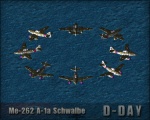Messerschmitt Me-262 Schwalbe
| ||||||||||||||||||||||||||||
The first "V1" prototype was ready in April 1941 however the BMW 003 jet engines intended for the aircraft weren't ready so a conventional Junkers Jumo 210 engine with a propeller was fitted to the nose so basic testing of the airframe could be carried out. It wasn't until November 1941 that a pair of BMW 003 were ready to be fitted to the prototype. For the first test flight the Jumo 210 was retained for safety, which proved wise as both BMW 003 engines suffered a flameout causing them to failed, the Jumo 210 was then used to bring the prototype safely back to base. With this failure it was decided to switch to the more reliable Jumo 004 jet engines. The first flight with the Jumo 004 took place on July 1942 in the V3 prototype, marking the first flight of the Me-262 with jets only.
There was opposition to the Me-262 from several high-ranking officials during early development including the head of Messerschmitt who wanted to concentrate production on proven propeller designs as well as the commander-in-chief of the Luftwaffe Hermann Göring who expected the war to be won before the aircraft could be ready for production, as such funding & support was withheld at times. After the Me-262 prototype was demonstrated to Hitler in mid 1943 he also insisted that the design should be modified into a multi-role fighter-bomber which lead to redesigns of the nearly finished fighter aircraft. These political problems along with the extended development of the jet engines meant that the Me-262 wasn't able to go into operation use until April 1944, six years after it's original conception.
Once in combat though it proved highly capable and able to outperform most allied fighters, with several pilots becoming aces. It was however extremely vulnerable when taking off or landing as it couldn't manoeuvrer or accelerate during this time or the engines would possibly stall. Allied pilots would take advantage of this by loitering around airfields & then attacking Me-262 as they appeared.
References
| 1930 - 1940: Pre-War |
1940 - 1942: Early-War |
1942 - 1944: Mid-War |
1944 - 1945: Late-War |
1945 - 1960: Post-War |
1930 - 1960: Total-War |
|
| Buildable | Yes | Yes | ||||
| Bonus Crate | Yes | Yes | Yes |


Enable comment auto-refresher